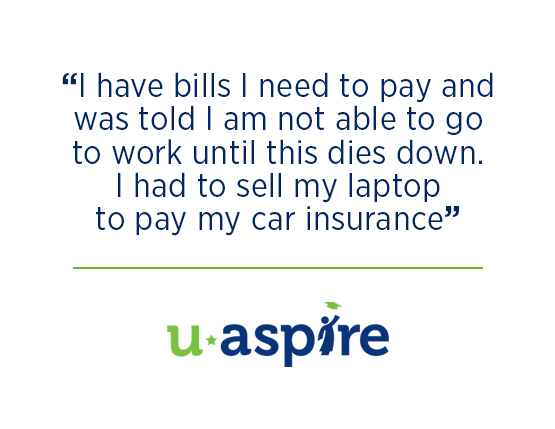Blogs
Student-Centered Solutions Needed During COVID-19
April 23, 2020
By Laura Keane and Tyler Wu

COVID-19 is disrupting the lives of college students across the nation. While urgency to develop solutions is vital to meet their immediate needs, this crisis exposes pre-existing inequities in higher education that require systems-level solutions, not band-aid fixes. Above all, it’s critical to listen to students in order to understand and identify the problems requiring practical on-the-ground solutions.
Our higher education, state, and federal leaders must provide the necessary resources to support students during this time. As budgets are stretched thin, we must prioritize investment in postsecondary education to prevent an increased share of the cost being placed on students. Rooted in our longstanding experience advising students, we believe leaders should:
- Strengthen financial security
- Widen access to basic needs
- Simplify financial aid processes
- Address broadband gaps
Strengthen Financial Security
When COVID-19 forced college campuses to close, many students also lost their jobs. The CARES Act left many 18 to 24-year-olds ineligible for earned wage replacement via stimulus checks. Questions around employment and the need for wages are top of mind for our students as they faced forced moves and increased expenses. As a student shared, “I have bills I need to pay and was told I am not able to go to work until this dies down. I had to sell my laptop to pay my car insurance.” Students need a safety net.
The federal government can help backfill students’ loss of employment wages by expanding stimulus check eligibility to include 18 to 24-year-old employed students. States should also help ensure employment and wage security by assisting students in applying for unemployment through an accessible and clearly communicated process.
Widen Access to Basic Needs
Even before the COVID-19 crisis, housing and food insecurity posed significant barriers for our students. Now due to closures of campus food pantries, being forced to move home, and/or navigating off-campus housing leases, our students are struggling even more to meet their basic needs. “I am currently in an unsafe living situation where my roommate doesn’t agree with social distancing. I can’t leave because I don’t have enough money to pay the fee to break my lease,” said a student.
The federal government should increase funding for public benefit programs and eliminate barriers to access such as by suspending employment as an eligibility requirement for SNAP. States should coordinate with social service providers to offer basic needs support for food, housing, and healthcare and promote communication channels to broadcast how to access these services. It is also vital to prioritize state investments for students most in need, particularly DACA/TPS and undocumented students that the federal government is leaving behind.
Simplify Financial Aid Processes
As students’ circumstances have dramatically changed, the process to access financial aid has remained the same. Due to the rapid and unforeseen changes caused by COVID-19, students are struggling to provide the necessary physical documentation to verify financial aid applications and renew financial aid packages. One uAspire advisor shared, “One of my students is required to print, sign, and send a document to their college’s financial aid office. Without a printer, renewing is impossible.”
More flexibility is needed to meet federal verification requirements by allowing financial aid offices to accept alternative methods of documentation and signatures. States should consider streamlining financial aid application forms and processes in addition to adjusting deadlines.
Address Broadband Gaps
Our students are worrying about their ability to keep up with academics and some have already withdrawn from Spring terms. Those still enrolled are struggling to consistently access their online courses due to unreliable access to technology and broadband internet. “I’m not sure whether I’ll perform well enough in online classes since I don’t have access to the same resources. I don’t even have a library or the tutoring centers because everything is closed,” said a student. Even when providers offer “free” Wi-Fi, caveats often limit access such as requirements to be a new customer or purchase hardware.
Increased federal funding should be allocated to the E-Rate program for the purchase and dissemination of Wi-Fi hotspots, modems, etc. to help postsecondary students access quality broadband. States should assess the digital divide within their communities and quickly fund solutions that will ensure access to high-quality and affordable internet.
As the federal government and states implement policy solutions, colleges must not wait to support students through the COVID-19 crisis. Every day, our students are overwhelmed by meeting their basic needs, navigating their education successfully, and filtering unclear information related to the crisis. Colleges can act now by quickly delivering emergency aid dollars to students in need. It is vital colleges update school websites with clear, transparent, and trustworthy information on how to receive emergency aid and access resources. Above all else, higher education, state, and federal leaders must listen to those who have been most affected by this crisis.